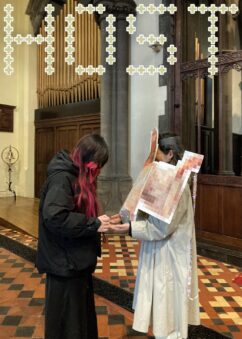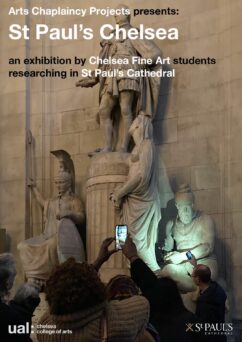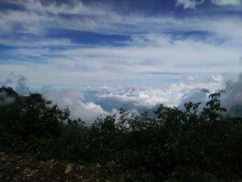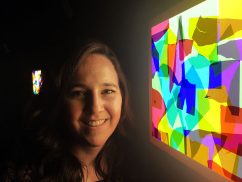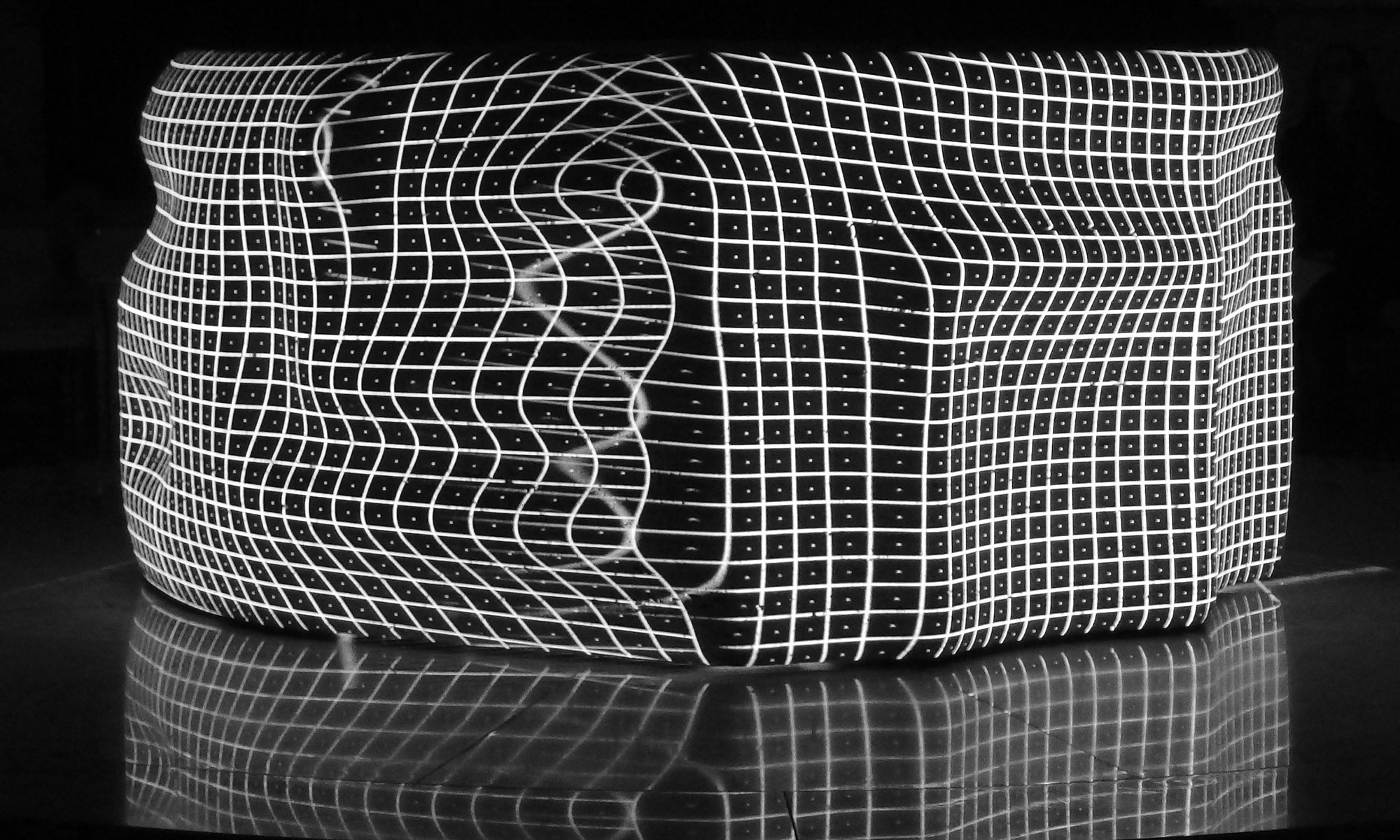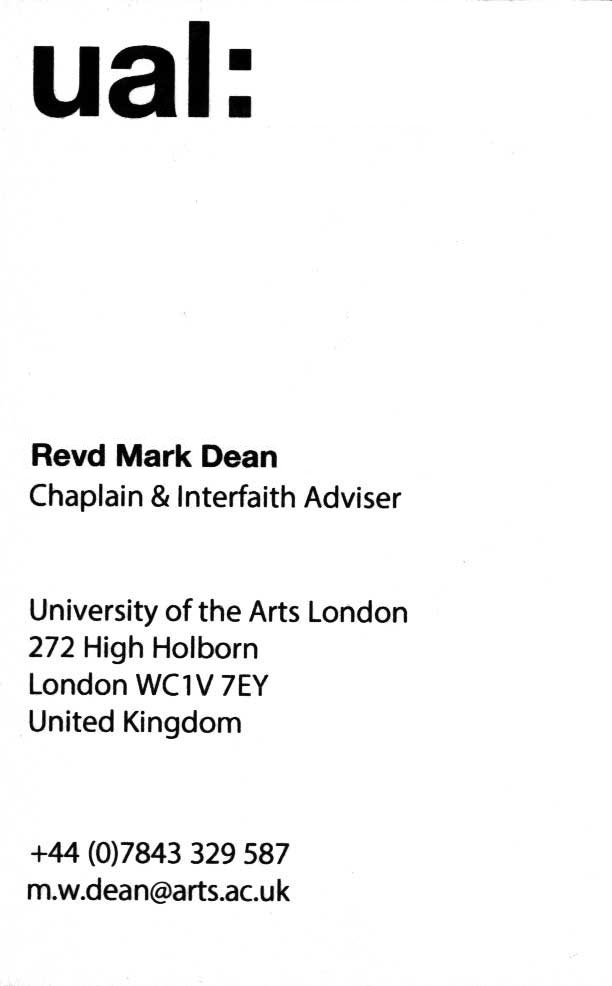David Leal + Nina Danino
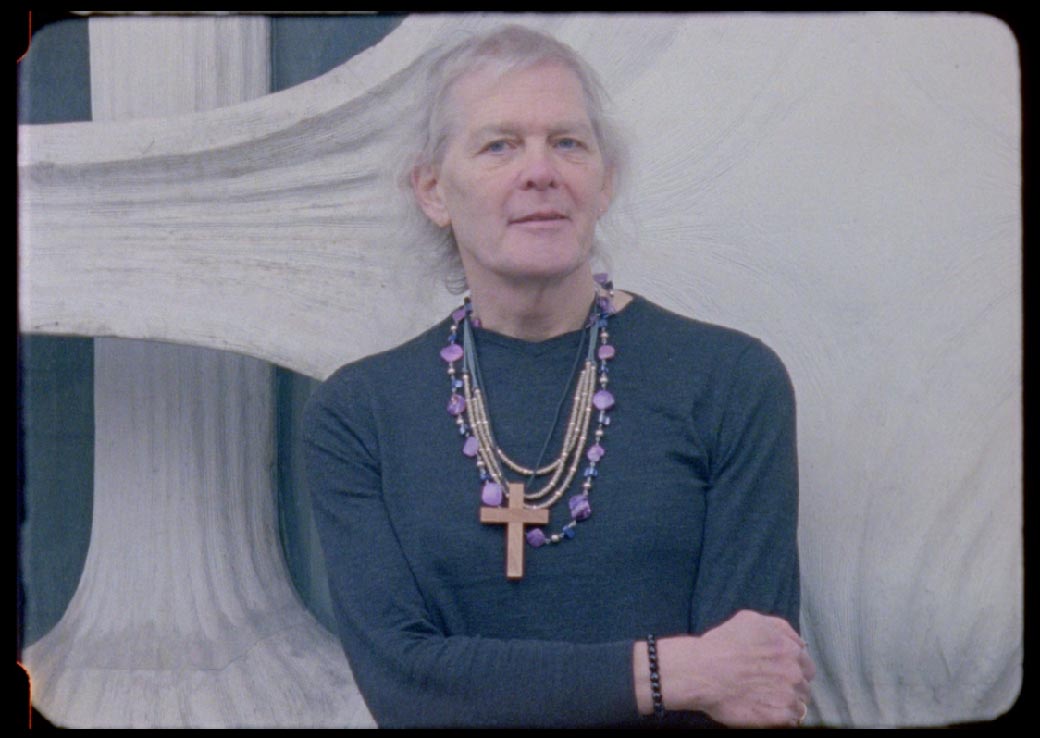
Film still: David Leal, You are a letter, written not with ink, but with the Spirit (2019) 16mm, colour and black and white, silent, 4 mins
WEEK 1
From: David Leal
To: Nina Danino
1st February 2021 at 16:57
Hello Nina,
1º of February of 2021, after a January that felt like a whole year.
Firstly, thank you so much for deciding to do this with me and for our warm conversation last week.
Thanks for watching the film I did with Michelle (You are a letter, written not with ink, but with the Spirit, https://www.davidleal.net/you-are-a-letter-written-not-with-ink-but-with-the-spirit)
I know the presence of the crucifix was something that you noticed and that led you to ideas on stability, I would love to know more about this.
This is the only silent video work I did ’til today, I wanted people to live her portrait in silence as they would if it was a photograph. Although, sound interests me in volumes, so for this work I decided to have the title spoken at the start, but no mention of it in the image, which I thought offered a secretive tone to the title.
But normally I go crazy with sounds, and crazier with voices. Your film Temenos (1997) made a big impact on me and occupied the whole room where I watched it in my laptop. I find it very PUNK. It kinda sits at the other end of the spectrum of, for instance, Diamanda Galás, but still with the same sensation, a voice that abrases feelings.
I feel inspired by your work’s voice and by the voices in your work.
*
And I want to run with voice in this email,
Last Wednesday The Goddess Bunny (Sandie Crisp) died, what an icon. And then on Saturday I woke up to the death of SOPHIE, she was incredibly talented and just 34.
You could hear Sophie’s voice all over today’s POP. And in her music, voice was normally sculptured to an immeasurable degree. I don’t know if you know her work, she created music for a long time anonymously, and then a single came out in 2017 where not only we could see her face for the first time, we could hear her real voice. https://youtu.be/m_S0qCeA-pc
(https://www.youtube.com/watch?v=es9-P1SOeHU a different example of her multi-voices)
I read on Pitchfork: In a statement, the record labels Transgressive and Future Classic wrote: “True to her spirituality she had climbed up to watch the full moon and accidentally slipped and fell. She will always be here with us.”
True to her spirituality she had climbed up to watch the full moon and accidentally slipped and fell, …the number of questions and images that this sentence affects my head with are so many. The motion, the idea of motion caused by spirituality, the idea of climbing up, the full moon, body falling down, the moon rising up, the upwards movement of closeness to light, the downwards movement of closeness to darkness.
My mind visits this El Greco which I love, https://upload.wikimedia.org/wikipedia/commons/6/6a/El_Greco_-_The_Agony_in_the_Garden_-_WGA10558.jpg where, behind Jesus, and occupying the whole background, we see a mountain, its peak, the full moon, the light in the mountain as if you could effectively climb and be closer to the moon.
I say goodbye for now,
speak soon,
David
From: Nina Danino
To: David Leal
5th February 2021 at 15:53
Dear David,
It was very nice to meet you and to discuss points of connection, to interpret this exchange for Mark’s invitation to Spiritual Exercises.
I think for myself, I need to start here and I did some research which I thought that I could share. The Spiritual Exercises were written by St. Ignatius of Loyola 1522-1524 and although I read his contemporary St. Teresa of Avila, I have avoided St. Ignatius and Teresa’s protégé the poet St. John of the Cross as her writing is a whole body of literature. She was one of the driving forces in the film “Now I am yours” (1992). It was exciting. I didn’t even know where it was taking me. https://www.google.com/search?client=safari&rls=en&q=bfi+player+nina+danino&ie=UTF-8&oe=UTF-8
With the Spiritual Exercises, we are in the Counter-Reformation and mystical Catholic thought which was the spiritual environment for these highly creative people in both religion and art – when the two weren’t separated as they are now and we can see this such as in the sculptures of Bernini and particularly in The Ecstasy of St. Teresa which is also in my film.
Of course, the Jesuits which Ignatius founded were for the purpose of mission and they have been the subject of action, adventure and overcoming adversity films including Scorsese’s The Silence (2016) and of course The Mission (1986) but it seems that Ignatian themes of ‘deliverance’ appear in many films, in ‘movies’. https://www.jesuit.ie/blog/brendan-mcmanus/ignatian-movie-guide/
The theological aspect of the Spiritual Exercises and Ignatian spirituality – from what I can read – is stern and is about method, choice, the control of the self and giving one’s self to God, which certainly is different to Teresa’s charge of excess. The Spiritual Exercises are not in the vocabulary of most of us today or only of very few (as it was then too) – it has an austerity.
What I found interesting about The Exercises which could work for us, is that their retreat structure matches our chosen structure of 4 weeks to carry out these exchanges. The Exercises are carried out over 30 days in silence and solitude – well we can say that we are in solitude because of the pandemic lockdown and this can imply a certain silence. And they are divided into four weeks with four themes which are; life, passion, resurrection, contemplation. According to the googled sources that I have consulted, The Exercises although originally devised for the teaching of Jesuit Spiritual Directors have become very popular today as ‘an occasion for a change of life or a school for contemplative prayer” https://en.wikipedia.org/wiki/Spiritual_Exercises_of_Ignatius_of_Loyola
In any case, in an Ignatian structure we are in week 1 which is LIFE (perhaps this structure or themes will peter out and that’s fine too).
And we were talking about your film about Michelle – who is a life. It is shot on 16mm and I really liked the colour which was slightly faded – was the stock out of date? It was a distinguishing aspect. Digital films have highly post produced colour from Resolve and other Grading applications. The location is the Oasis Church (formerly Christ Church and Upton) where your subject Michelle is filmed against the modernist facade of the church that too was striking.
Yes, I mentioned the crucifix that Michelle was wearing because it was a big wooden carved one and you couldn’t miss it. It made me think about stability and instability because dominant symbols especially of faith or of affiliations of identity can do this. Also, it was unfixing because it made me think about the decisions in the film and you as a director. You later said that you really thought about whether they should wear it or not perhaps it needed not to be there. Also of course the meaning of the choice to wear it for the film by the subject – by Michelle – as it is a portrait of them. It made me think about how excessive faith can take people to a border and also how these symbols can stabilise and destabilise borders and how religious symbols can represent unstable borders to others.
So, although it interfered in these ways, it has made me think about the decision to have it there and the presence of the object itself presented a destabilising intrusion into the film itself in these ways too.
Temenos – I have never thought about it as PUNK – I like that – perhaps you can say more about your definition of this if you want – Diamanada Galás’ voice is part of the vocals in “Now I am yours”. In Temenos everything is done for the film by the voice of Sainkho Namtchylak. I speak the lines, including of the child at Fatima, Lucia – maybe we should return to Fatima in the next exchange. This is very far and a very different visionary to the Counter-Reformation poetry, writing, painting, Ignatian theology and mystical Catholicism – with Temenos we are in the landscape of popular devotion often of women and children. https://letterboxd.com/film/temenos/
If you want to stick to the voice, I could mention fado. I have to tell you and I hope it doesn’t annoy you – I know the famous Amália Rodriquez https://www.youtube.com/watch?v=uFgctURyGp4 and Maritza https://www.youtube.com/watch?v=SU2xGmhoX1M but fado is too heavy for me – it is always sad and nostalgic- melancholic – it is very different to the similar Spanish form of copla which is sad but has strong emotions in it. Perhaps we can also talk about these differences next time.
I was so sorry to hear about the death of the two artists THE GODDESS BUNNY and SOPHIE. Thank you for introducing me. El Greco, looking at the mountain behind Christ, a heightened and landscape full of vibrations – we are back in the visionary space of the Counter-Reformation.
If you like the suggestion we could use the structure of the Spiritual Exercises and do a weekly exchange of one e-mail between us.
If so, may I suggest that this is Week 1 and we think about Passion for Week 2. Perhaps you can talk more about the dark passion and your voice in the vocals for BAT conversations which really attracted my attention as it sounded like a howling voice quite trapped, desperate and imploring.
Best wishes
Nina
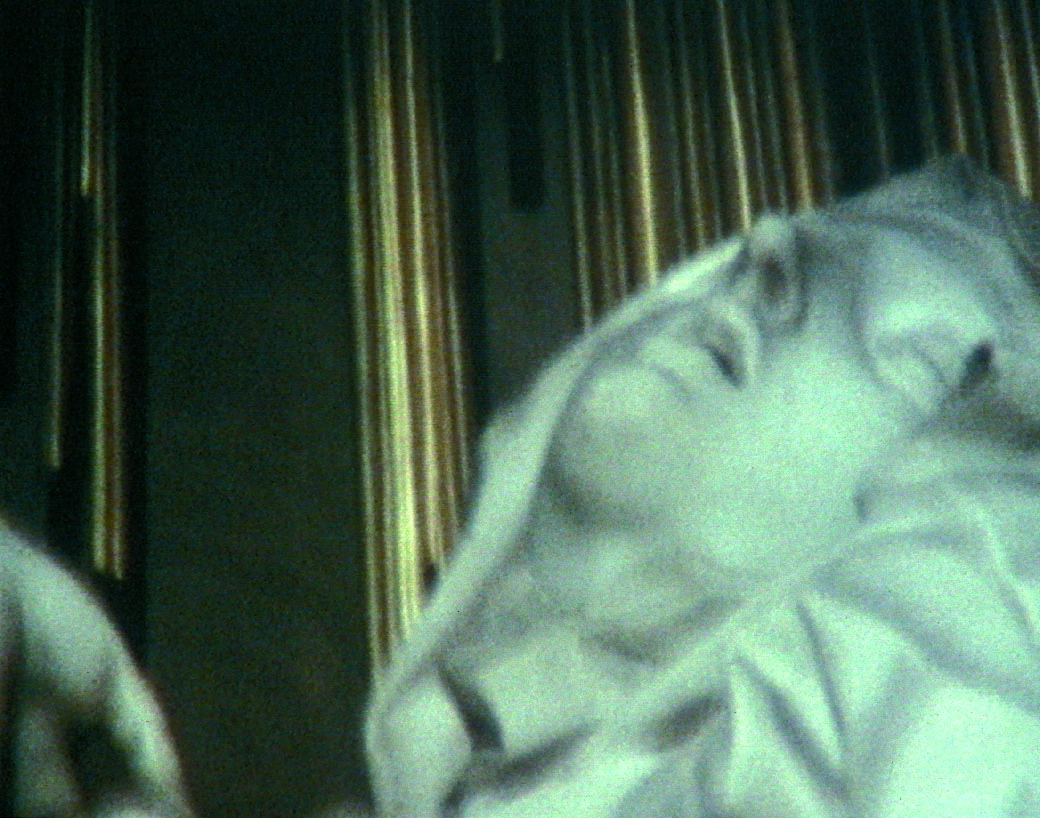
Film still: Nina Danino, Now I am yours (1992) 16mm, colour and black and white, sound, 32 mins
WEEK 2
From: David Leal
To: Nina Danino
10 February 2021 at 18:20
Hello Nina,
I think your idea is wonderful and gives a whole tone to our correspondence.
Let’s do it, let’s undergo on our own spiritual exercise.
PASSION
I wasn’t aware of St. Ignatius of Loyola, neither of St. John of the Cross. Two more figures for me indulge in.
Nice coincidence that you refer to Scorsese’s Silence, I watched it for the first time around a month ago. I think it beautifully dresses a gigantic idea, a Silence with so many layers: literal, abstract, meta. (Also the fact that the characters are Portuguese made the film a lot more provoking to me in many ways. I am interested now in reading the book. Also triggered by the painting of El Greco in the film.) I haven’t watched The Mission but I definitely will, and the movie guide is an interesting one! Even though some of the choices seem to be only related to the ‘hero’s journey’ more than the Ignatian path.
In relation to passion, and to St. Teresa of Avila, which I wouldn’t even consider myself a novice on, I know although that she, by the things I have read over the time about her, that she was a pointedly visual person, i know that images had a tremendous impact in her and her mind — and her mind would eventually have a tremendous impact in images. I know that she had been affected by looking at images of the Passion of Christ.
(As I wrote in my dissertation ‘how should one feel when looking at stigmatas?’, I wrote a lot about vision and looking as a transmitter of senses, feelings, pain…, she would have been a great addition to this idea…)
I believe the hyper-sensibility and self-consciousness that inhabit her eyes were the great enabler for her visions.
*
I’m always fascinated by eyes and they have become a main motif in my work. Especially fundus images, I have an endless fascination with them that started by finding hundreds of them from an abandoned hospital in my hometown.
Looking at them is like looking to the back of things, lifting up the veil.
And where things can be engraved, like a cave painting. Things like Passion(s).
In my film Rest Oration (2020) I performed an eye examination to an El Greco painting. (A painter you can tell by now I lose trying not to mention him too much) https://www.davidleal.net/rest-oration-2020
(In this film I worked the voice in a similar way to the work BAT (Conversation) I presented in the first Spiritual Exercises series. A voice that is both screaming and quiet, shy and arrogant, a voice that struggles to speak. In BAT I wanted the voice to be textured like the interior of a cave, in this one to be dragged like the images themselves.)
*
I love the fact that I mentioned Gálas and, not only she was connected to your film Now I am Yours, is also the film that connects with Teresa of Avila and the theme of Passion. (Gálas’ voice for me can many times be understood as the personification of passion, the bloody passion, the one that got Avila’s eyes.)
I really understand what you mean about the film I did with Michelle. Your comment on stability and, by extension, the wood crucifix, penetrated the film and now I cannot not see it. I see stability as something that is noticed by the shaking of something’s limits and borders, and therefore, the contingency of things. In the binary reading of gender, Michelle’s figure makes the contingency of those binaries weak and diluted, which is something that people in her church notice a lot, making her more aware and conscious of it, but then this fact also becomes something that allows her to have a highlighted voice in her church, which is good for that community.
*
Back to the theme of passion, it is interesting that you mention Fátima (I was very surprised to know of it as one of the locations in Temenos, which I love). When I was young I used to go on holidays with a group of boys to a Paulist group in Fátima. It was one of the places where I first felt Passion (the eros type), and due to my queerness and the place’s religiosity, Passion (suffering) for the Passion (eros). One passion was revealing me and the other suppressing me.
I called Temenos punk because it is something I like to call to every object that is unapologetically something. In the case of Temenos, the weight of the experience of the spaces with the voice is so unapologetic. I would call the same to the popular devotion you speak of in those places.
*
I totally understand the heaviness you note in Fado, I think is a weight that relates a lot with passion, the loss of it or the overdose of it…
***********
I came back to complete this email today. It is easy to write about passion on a day like today, with sunlight and snow, both happening at the same time.
Also, today I have watched Now I am Yours (through the box of broadcast, a programme on Channel 4 aired in 1993), magnific. Pouring passion.
It made me think of a video work by Marianna Simnett, Faint (2012) which she makes herself faint in from of the camera
*
For me, passion is also the back of a painting by Albrecht Dürer of St. Jerome.
https://www.nationalgallery.org.uk/paintings/albrecht-durer-saint-jerome?reverse=1
How incredible to have that beautiful painting in the front and then this speechless back. I guess maybe I see this painting relating to what I previously described as the back of the eye. The magic that exists in the back or the interior of things. Passion’s interior, like the interior of an eye, is full of nerves and directly connected with the brain/soul.
https://www.davidleal.net/fundus
*
Best Regards
David
From: Nina Danino
To: David Leal
14th February 2021 at 16:55
Dear David
PASSION
Yes, on your website you use the motif of an eyeball and veins for each work, they are digital images of scientific photographs of the retina. The video you suggested watching is of a painting of a figure with eyes upturned to heaven. It could indeed be the form of fainting but the fainting woman is a modern via the hysterics of Salpêtrière. I think this figure is not a hysteric, she does seem to be fixed on a point but her eyes are not staring in a blank way, they are watery with tears and her hands are composed and tranquil and she appears serene and not in turmoil.
I watched Rest Oration (El Greco) 2020 https://www.davidleal.net/rest-oration-2020
Your video acted as a catalyst to some uncoverings. It is a nice story of a sort of mad restorer – a science fiction Chris Marker or Kubrick-like character.
It concerns footage of a restoration of a painting in a museum. At first I did a double take – is it you doing the filming? It looked like a museum conservation laboratory. I double checked and the electric blue of the text on your website page says that the video ‘“imagines a fictitious restoration of a painting whilst giving it a life of its own” and also that it is part of a project Speaking in Tongues 2020, a performance-based project devised by Fine Art Students…in partnership with The National Gallery – so I wondered, could students have been given access to a painting restoration? I take a lot at face value or I try to see what is represented first of all. But then, it also says that it was made during the pandemic when museums were closed. Even in normal times, it would be unusual to be given access to the restoration of a valuable painting if you aren’t a TV crew with all the insurances.
I like the opening of the video which are shots in the museum gallery where a man – the restorer – is looking at the painting in situ before it is brought in for restoration. As the footage in your video is highly treated- the footage is slowed down and the restorer’s voice is also slowed down, it also has a voice track and subtitles added to some of the words of the restorer which are now slurred and can’t be (aren’t supposed to be) understood clearly, I felt intrigued and it took me to You Tube source which is possibly your source https://www.youtube.com/watch?v=uhPV0Bm0dqQ
This is a You Tube uploaded section of longer documentary of a restoration of an El Greco painting in the collection of the Nelson-Atkins Museum, Kansas City, US. They are getting it ready for an exhibition of El Greco in his home town of Toledo, Spain. The worst part of the introduction was one of the presenter’s reference to restoration as making the painting look ‘fresher’. Someone else on You Tube also comments on this.
The painting is El Greco’s, The Penitent Magdalene, c1580 who is the figure of Mary Magdalene looking upwards as if to heaven at an absent Christ https://art.nelson-atkins.org/objects/30704/the-penitent-magdalene
This got me looking into the theme of the post-Christ Penitent Mary Magdalene which has been painted by Caravaggio, De La Tour and many others. The theme is usually but not always, set in the Magdalene’s time as a hermit in the desert after Christ’s death. She is painted in a setting which signals harshness, the reality of death (a skull sometimes), the jagged stone of the desert, aridity and the desert as a place of penitence for the Desert Fathers (200 years later). So although we are in PASSION in the Ignatian Spiritual Exercise, this passion is within the framework of austerity and the austerity of the desert. Despite the desert, she always has the luxurious jar of unguent by her which she uses in her extravagant gesture of penitence by pouring it over Christ’s feet. Mary Magdalene was supposed to have had a passion for Christ and indeed her gesture is passionate. Mary Magdalene in her hermitic post Christ years must be the prototype for the women hermits in the desert who came later as she ended her life in abstinence, penitence and ashes. http://www.moyak.com/papers/christianity-hermit-desert.html
These early hermits both men and women were fleeing to the desert to lead solitary lives probably in the 2nd and 3rd centuries, they lived in caves and in another El Greco Mary Magdalene in Penitence 1578, she is sitting in front of the cave which is seen more clearly – perhaps from within the cave you can hear the voice of a man shouting out muffled and strange as if in combat with a devil. It is the voice of St. Antony who is the founder of the Desert Fathers and is supposed to have combatted the forces of evil in a cave calling out – this is what reminded me of your BAT piece – I think it is the other way round – the sound in your BAT piece reminded me somehow of an ancient fight with some evil force. So now you can also be St. Antony the Great (of Egypt) calling out in your desert cave.
El Greco painted it seems 10 Penitent Magdalene’s and of course there are many others by many painters and sculptors.
The Magdalene in the El Greco painting you have chosen, presents a very enriched almost an 18th C French court figure with luxurious flaxen curls of hair and silken fabrics around her. But the stone and the clouds and weather are harsh, her skin is alabaster (it reminded me of the film I will end on). Some comments in You Tube on the section of the original documentary noted that the restorer did not wear gloves and put his arms on the painting, blurring this alabaster with his brush – it was alarming to see how careless it all was. He is talking about removing the previous restoration which made me think about the picture – whether what we see now has anything left of the original El Greco or is it a palimpsest of restorations.
There is a nice account of the Jungian take on Mary Magdalene whom Jung does not consider an archetype like the Virgin Mary and is thus more empowering for women. He says that the figure is a figure of struggle in real life and thus can be a role model to contemporary women having the individual choice to set a course for their lives. He was talking about women in the 1940s (circa?) – whereas following archetypes leaves one less free and prone to persecution if one deviates from the norm with originality. I’m not sure it is so divided – the Virgin has a reality to believers and she has her own stories and decisive acts. https://jamanetwork.com/journals/jamapsychiatry/fullarticle/1471404 But perhaps if we go back to Fatima where I would like to go to your story and Temenos we can think about the Virgin.
It should not be overlooked that Mary Magdalene was active, she followed Christ and is present in the Gospels and is at the foot of the cross – although there is a mix up about this as the three women at the foot of the cross are all called Mary. She is thus often interchangeable with several Marys in the Gospels who are disciples. But despite these overlaps she is not an archetype but a particular character with her own story. Mary Magdalene is probably inexhaustible so I shall end here.
If I can go to the eyes which are what interests you. Sometimes the Magdalene’s eyes are painted with tears, in the El Greco painting of 1580, they have a sheen, looking upwards, like a young woman with shinning eyes and it is the most realistic and naturalistic of all his Magdalenes – the other ones have an elongated and angular face which is stylised and belongs to the Mannerism which he is known for, which is to me is too mannered although it is vibrant with colours – it is very modern and we are familiar with it but he must have appeared an outsider and a sort of madman in the 16th Century.
So just finally back to the restoration scene – the restorer with his magnifying spectacles to enhance his vision made me think about the dissection room, the operation room and of the impulse to see and of course this took me to the famous Stan Brakhage film The Act of Seeing with One’s Own Eyes (1971) which is using an instrument – the camera – to see. Perhaps this kind of seeing relates much more to the scientific form of seeing. Techniques of the Observer (1992) is a good account of this history of the instrumentation of vision in the 19th Century. I found this complete copy on squarespace! It gives an account of a social construction of subjective vision and of the new instruments which measure physiological optics.
Crary_Jonathan_Techniques_of_the_Observer.pdf
Stan Brakhage’s film seems to want to engage head on with the act of seeing through the instrument of the camera but the camera is also itself a tool of social status which gives him entry to film autopsies in a city morgue – which would normally be forbidden to public viewing (just as the restoration of a valuable painting is – although now we can access interminable footage of both on the internet). The alabaster of the Magdalene also reminded me of the bodies in the morgue, as he films cadavers. https://lux.org.uk/work/the-act-of-seeing-with-ones-own-eyes1. Anyway, as you know, Stan Brakhage was very much thinking about the eye and the camera as a machine or apparatus of vision as both together creating a new vision. He devised his film theories and published them quite early on in Metaphors of Vision(1963) https://www.criterion.com/current/posts/4959-reintroducing-metaphors-on-vision
Thank you for making me think about all these things which come out of Rest Oration (2020).
I look forward to your next e-mail as we enter WEEK 3 on RESURRECTION in the Spiritual Exercises. We don’t have to add new things, if there is something that we have already said we can also go back to it and look at it more closely – or not – if there are other things that’s fine as well. Each week may bring new experiences that we want to bring in.
Best wishes
Nina
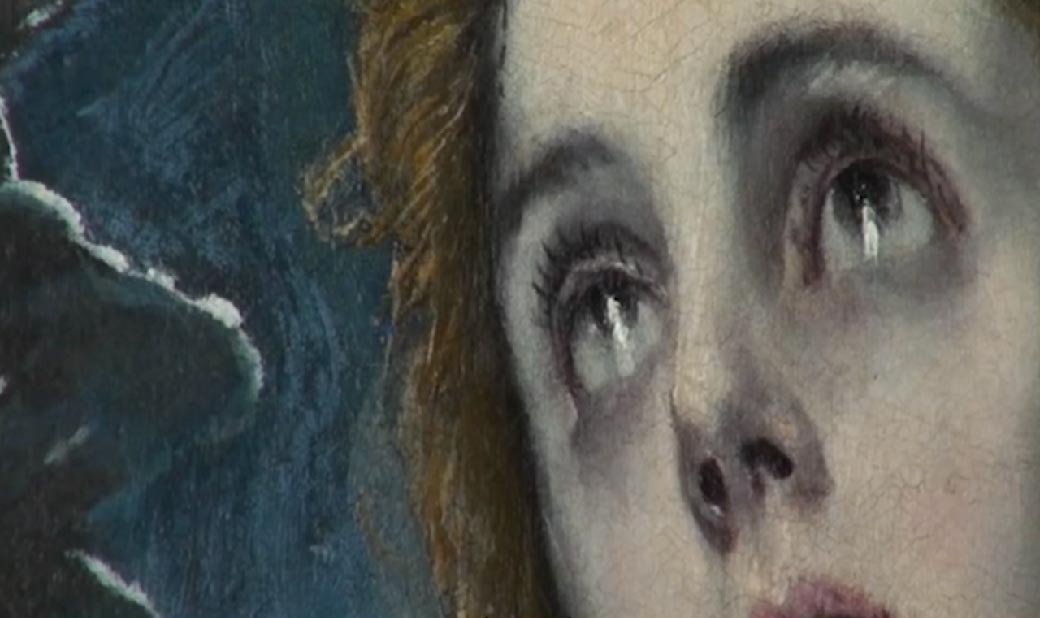
Film still: David Leal, Rest Oration (El Greco) (2020) digital, colour, sound, 8 mins
WEEK 3
From: David Leal
To: Nina Danino
19th February 2021 at 16:57
Nina,
such a joy to read your email,
RESURRECTION:
It is interesting that you mention Salpêtrière. It is a place where my mind fantasizes often. I imagine (putting apart, if that is even possible, the violence and the scrutiny imposed on those women) how fascinating a place it probably was, how incredible must have been for having all those interesting minds strolling around.
And I think about how it is still a place with a strong energy in time. How many lives had their end there — for instance, and more recently, Princess Diana.
It also makes me think of one of my favorite Portuguese movies, from 1974, Jaime: https://youtu.be/nPZDgHzjZ2Q (I can only find it with French subtitles)
A film that focuses on the life of a deceased psychiatric patient, Jaime Fernandes, an artist who started painting when he was 66 after many years as an inmate, is also beautiful how the film observes the psychiatric hospital…
(“if I had a concern it was of a moral nature: to uncover and destroy the border between normality and abnormality, without parti-pris, for the simple reason it is in my blood and in my intelligence, and because I am convinced that a large part of the freaks are out here and many of them even normal, hospitalized.”)
*
I think it is very interesting how from my Rest Oration you landed in the actual restoration. And I am surprised how that curiosity in relation to the comments of the video and the care taken by the restorer completely passed me by. I guess I was inside her eyes too much which, in itself, maybe is as violent as being a careless restorer.
*
Fresher is one of those words made completely redundant by brands and advertisement, some are quite shocking for me,like Pure, everything is pure now.
Just like the constant violent reconfiguration done to these adjectives, I feel like the same was done to Mary Magdalene. She was a channel to so many ideas on femininity and, to repeat, what is or not Pure.
The idea of penitence and the weight of this word strikes me every time. Takes me straight away to this Donatello sculpture, which I find so hard + mesmerizing to look at. Probably one of the boldest at expressing the sense of hermit.
Is very interesting how we could also talk about this work in relation to restoration. It was restored after being damaged in the 1966 flood of the Arno and its current colour is due to that restoration.
Also, one of the restorers, when washing its feet, found a piece of gold in it.
“a reminder of her former beauty and sensuality, an emblem of her honouring of Christ and of her repentance, and a symbol of her neglect of worldly things during her life as a hermit saint.” – Bonnie A. Bennet
*
That’s the reason why I like El Greco so much, the way he painted eyes. Instead of having the usual light reflection givinglife to the eyes, many of his figures have what looks like a white flame inside them. Looking towards the sky, as if light could melt their vision & their point of focus lies somewhere higher than the atmosphere. I believe that before him, and by influence of the masters Da Vinci, Raphael, or Michelangelo, European art was too stuck in the rationalisation of sight (I borrow the term from William Ivins) but with the freedom of Mannerism’s asymmetrical or unnatural elegance, he was capable of producing mystic work, even if under the religious system. And, by proxy, we could call his work mysticism of sight.
Also, the fact that he was forgotten and it wasn’t until the Romantics that his work was resurrected…
not only his work but the type of mysticism of sight I’m talking about… gotta love them.
*
Also, because you mentioned Saint Anthony of Egypt, I need to mention my absolute favorite Velazquez: https://cdn.britannica.com/38/130338-050-24EBD5C4/Saint-Anthony-Abbot-canvas-oil-Paul-the-1634.jpg
(the caves… the caves…)
Thanks for the film recommendations, all unknown to me and speak so much to what I’m now keen on.
*
Now back to Resurrection: I think this would be a nice theme to touch on our conversation about working on religion at creating artwork inside the current academic art system. You asked me how I felt in relation to that and I can tell you now that maybe I see it related in a sense with resurrection, even without being able to map how. I feel, at times, a resistance in people’s reaction towards a work that relates to religious belief. A resistance that doesn’t exist when the subject is spirituality, but that exists in theological content when not with a satyrical dynamic. As if at doing so the work was trying to resurrect something that shouldn’t be lifted up.
I see, blindly, my work engaging with theological content in a way that is neither satirical neither honourable, but simply doubtful yet staring at it — even though I find myself in this secular modern comfort, I also cannot deny a Christian lens in my eyes. A type of doubt that makes me want to put the finger in the wound of a resurrected body.
Maybe you want to speak more about how it is to be on the other side but in the same situation, not as a student but as a teacher…
*
Still about resurrection the other day I bumped into some murals on Instagram that I fell in love with.
They were made by Maxo Vanka and are at St. Nicholas Catholic Church in Croatia
https://nextpittsburgh.com/wp-content/uploads/2016/02/unnamed-3-1.jpg
Look especially on the right how the body of Jesus is being taken by an angel, I thought it was beautiful…
*
Big hug,
David
From: Nina Danino
To: David Leal
22nd February 2021 at 16:52
Dear David,
Thank you for your wonderful energetic prompts, thoughts, paragraphs, links and questions.
You asked me about my experience of religion in academia as a teacher. In terms of students using religious ideas or symbolism in their studio work, I have found them to be very shy and reluctant to be upfront about it and also, they couch it in ‘spirituality’ or more acceptable terms in the art world as you say. If I have met any I want to give them permission to do what they want to without inhibitions – being PUNK as you say. Just to talk about it can be self-empowering. On the other hand, I hope that I can also apply the same analytical criteria and not privilege any type of work as exempt from critical autonomy. I think the Religion and Art symposium was also possible because I came across atomised practices in Art Research and in UG which were making work about these questions and interests but which were labouring under different terminologies or making themselves as invisible as possible. This issue of pedagogy and religion came up in the symposium particularly in the presentations of Lucy Newman Cleve and also Mark Dean’s and later in the post symposium discussion. www.religionandart.org
There is so much more to exchange with you about this – the Religion and Art Forum hopes to take these discussions further.
On the other hand, Christianity and Catholicism in particular have highly developed visual language of signs and symbols which can be fixing for artists and makes us ask how can one use them? It applies to all representation. We discussed this in your film Michelle “You are a letter written not with ink but with the spirit” (2019) and the crucifix. It can be very difficult to use because it stands out because of the separation of religion from art in modern and contemporary art and art academia but each artist who wants to use these symbols has to negotiate it individually.
Thinking about the RESURRECTION now.
In the 90s I used film – Hi8 and Super 8 to visit the processions which I had never experienced because my mother didn’t like them and never took us to them as children, so I was interested in their history and iconographies and to enter into the religious world of the Spanish 16th Century. The Sacred Made Real (2009) https://www.nationalgallery.org.uk/exhibitions/past/the-sacred-made-real The sacred music and literature of the period is considered the peak of Spanish religious art. As to the saeta – it is sung in the processions live but I had already, seven years earlier asked my mother to sing it. The processions take place in Holy Week so really are about the Passion, so they would have fitted into the previous Exercise better, but they are building up to Resurrection. Where are we now? Lent started with Ash Wednesday last week. When I was filming in Seville, it was bewildering, so many processions, the map of the city was criss-crossed with myriad processions, it was difficult to decide which one to follow – I was most taken up with the music of the marching bands and of course the saeta singers but on Friday it all falls silent. They reach their culmination on Good Friday with The Silence which appears in my film The Silence is Baroque (1997) which is filmed deep into the night (this was in Granada). The film crosses to the ‘other side’ perhaps of the Guadalquivir into the joy and light of the next day. There are fewer processions after Good Friday. I filmed one on Holy Saturday in Seville. These three days were especially important in the liturgy of the music of Tomás Luis de Victoria who was writing at around the same time as the effigy of The Silence in my film would have been carved. Here are the Lamentations for Holy Saturday https://www.youtube.com/watch?v=G69yRobm9Q4. But processions are about popular devotion and it is a different music. I followed one on the famous Parra street in Seville where a singer comes out on a balcony – a man and later a woman further down the street but I only included the woman singing in the final cut. There were even fewer processions on Easter Sunday, perhaps none. I left Seville on Easter Sunday which is the Resurrection. https://www.amazon.com/Rupture-Rapture-Jouissance-Religious-Trilogy/dp/B085MMDFZ5
Thank you for Jaime (1974) – it is about a psychiatric patient who made drawings. The film shows what can be barely called an institution – the beds are rusty, there are no flowers in the centre court apart from the sunlight and the seeming lack of a regime which meant that the patients – if we can call them that – are allowed to lounge around outdoors freely, it looks like a sort of hell. As a film, why was the music screeching over the drawings, which were made out of torment? The film showed sunlit suffering. I wonder why you love this film so much – but then we could have a private conversation about this.
I look forward to CONTEMPLATION with you.
Nina
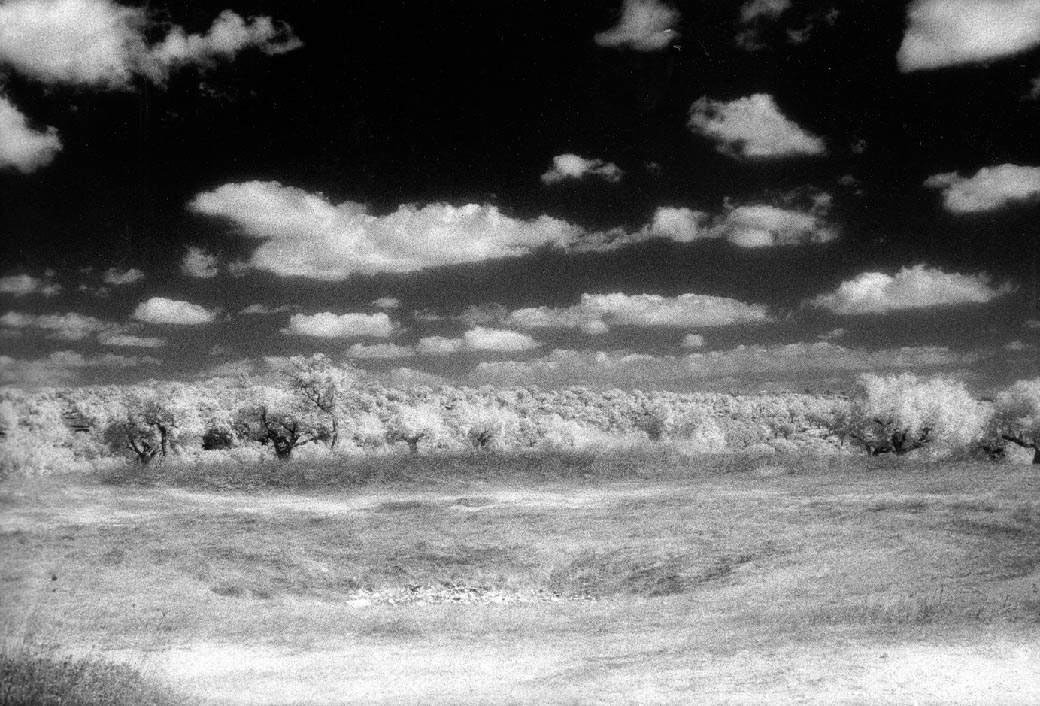
Film still: Nina Danino, Temenos (1998), 35mm/16mm/Beta SP, colour and black and white, sound, 75 mins
WEEK 4
From: David Leal
To: Nina Danino
24th February 2021 at 16:08
Hello Nina,
Thank you for your views on religion & academia, I am of the same mind.
I watched the Religion and Art symposium which was great, also because I was able to watch your amazing Stabat Mater.
I got surprised with the use of Ulysses, I wonder if you are a Kate Bush fan, if you know about this one song that came out in 1989 that uses the same lines https://www.youtube.com/watch?v=h1DDndY0FLI
Interesting how you were referring back to Passion and, on the video link for the music of Tomás Luis de Victoria, one of the comments says: “masterly thinking, is that what they call religious passion?”
And thank you for your story surrounding your The Silence is Baroque, which is such a powerful and evocative title (and makes me think differently about the use of the word silence in, for instance, the contentious words of Wittgenstein.)
I have never experienced a pilgrimage but I have experienced some times the 13th of May in Fátima, the day of the apparitions and the one which people commemorate and to which people from many places go on a pilgrimage to.
*
So now, CONTEMPLATION,
I watched a video that described Ignatian Contemplation as the week/step which most relates to imagination.
(~The prayer develops as you “live into” a scripture story with all your senses and imagination/ ~Imaginative prayer, is an active way of praying that engages the mind and heart and stirs up thoughts and emotions)
Now about this we could say so much…
Summing to the fact of this being our last week, which in itself makes me want to write so much, we are offered such a powerful idea.
I feel like suggesting us to do a similar exercise (be in a place within the mind) with Fátima, something we both know: “the Lady more brilliant than the Sun” they said.
“Newspapers published testimony from witnesses who said that they had seen extraordinary solar activity, such as the Sun appearing to “dance” or zig-zag in the sky, careen towards the Earth, or emit multicolored light and radiant colors. According to these reports, the event lasted approximately ten minutes.”
https://d3qt4cdqz6yc2s.cloudfront.net/images/2016-Miracle-Sun/6Miracle-Sun744x525.jpg
https://upload.wikimedia.org/wikipedia/commons/4/4b/Miracle_of_the_Sun.jpg
Looking at this pictures my mind imagines myself somewhere in the crowd
and I think of the numerous pilgrimages on that day to see it.
I imagine that, what was seen, could definitely be related to ideas on the Sublime.
In another article:
“Then the immense disc began to “dance.” The sun spun rapidly like a gigantic circle of fire. Then it stopped momentarily, only to begin spinning vertiginously again. Its rim became scarlet; whirling, it scattered red flames across the sky. Their light was reflected on the ground, on the trees, on the bushes, and on the faces and clothing of the people, which took on brilliant hues and changing colors. After performing this bizarre pattern three times, the globe of fire seemed to tremble, shake, and then plunge in a zigzag toward the terrified crowd.”
This image of circles and their movement takes me to some of the Old Testament visual ideas on angels, like the Ophanims…
“The Ophanim, or “the wheels,” is arguably the most bizarre being in the Bible. Ezekiel’s account in the Bible describes them as beings made out of interlocking gold wheels with each wheel’s exterior covered with multiple eyes. They move by floating themselves in the sky. As the highest in Maimonides’s hierarchy, they are tasked with guarding God’s throne.”
(This reminds me of this oddity: https://youtu.be/F2D1FvA22cM)
Jack Parsons, Aleister Crowley’s hand-picked acolyte, that was working for NASA (JPL), believed he had seen them; he was one of the first Americans to, reportedly, have encounters with UFOs in 1950. His wife (Marjorie Cameron, the same that Kenneth Anger filmed) postulated that the 1952 Washington, D.C. UFO incident was a spiritual reaction to Parsons’ death. He was also befriended by Hubbard who, in 1950, also released the first edition of “Dianetics” and introduced the first seeds of the money-spinning UFO cult of Scientology to the world.)
*
Back to the start: I daresay that imaginative prayer can be a such a great method to be used in the arts,
“You trust that God will be able to work through your imagination”.
I think that maybe this was the exercise I did with the BAT (Conversation) video, I imagined a fictitious scripture scene in a cave and what I would find there.
This could also be seen used, for instance, by Dali, in painting this: https://www.youtube.com/watch?v=PJ9YbFfKtqA, inspired by Fátima’s apparitions and one of Sister Lucia’s secrets.
(The idea of entering the scriptures and living the writings is something I believe many of the names we have previously mention do/did too. I can recall, for instance, Diamanda Galás who, I read in an interview not long ago, was talking about the story of Job, and how she goes back to it many times always having the feeling that she hasn’t explored it enough, or wanting to take new things from it — such a bold and great one to return to and be with).
Or, we could also say that this exercise of letting ourselves live in the text with our imagination, can takes us back to the Kate Bush song I previously mentioned, in which she says in the chorus: “stepping out from the page into the sensual world”, the text as a gate from which worlds open, some of them sensual.
My fascination with the bible is partly due to the easiness of being inside it. (Is it really? Or do I want it to be?)
In relation to art I think many times on ideas of telepathy, and call that to a certain sensation some pieces give me in which I feel like a kind of communications took place. With Ignatian contemplation is not so much telepathy but is still the allowance for one to penetrate something, to be taken from a place of encounter to one of surrender.
like when in a Tarkovsky movie a mysterious glass falls, almost because of you, the viewer. it is not the camera that walks between the divisions in a house but you, yourself.
*
That is a place where I found God: the imagination.
Like imagining where a crown of thorn, in levitation, mutates into an halo.
https://www.davidleal.net/o
*
Ron Athey, whose work I really like, said: “I guess Eastern things don’t call to me. I’m not a Buddhist. I don’t follow a guru. None of that floats my boat. I guess in a category I already considered myself Christian. I’m against nihilism. That was also a premise of making this—what does that mean? If you’re going to get rid of God and religion, you don’t just walk in the freedom—you walk in the emptiness.”
http://www.artnet.com/artists/nan-goldin/fatima-candles-portugal-rq1lRRcRvaGie0vKI0evfw2
Thanks for this super warming correspondence, can’t wait to go it with you face to face.
Speak soon,
David
From: Nina Danino
To: David Leal
22nd February 2021 at 16:52
Hello David,
Thank you for your amazing responses which I look forward to more and more.
I will reply in Contemplation.
Nina
From: Nina Danino
To: David Leal
1st March 2021 at 16:57
Dear David,
What a pilgrimage you mapped! Full of crazy stories going from one of your links to another – I particularly liked what you call ‘this oddity’ of the NASA UFO images of Merkabahs and Ophanim (!) via Kenneth Anger, Aleister Crowley, Dianetics and Scientology to the Miracle of the Sun in Fatima (2017) and the black and white photographs of a vast crowd of peasants – as many as 70,000 came and completely tore up the place all looking in the same direction. Apparently, it had been raining the night before and the ground was muddy and soaked and the sky dark and cloudy during the day. In Temenos, I filmed in the environs of this place and the weather is part of the manifestations throughout the film. The crowd fell on the tree where Lucia and the other two children pointed and tore it apart for souvenirs. The film director Federico Fellini references this event in one the sequences of his masterpiece La Dolce Vita (1960) – one of my favourite scenes is the apparition event when the crowd falls on the paltry tree-shrub and tear it apart – it is very funny and the children lead the crowds on a merry dance after the Madonna.
Then, we have the crazy conversion of Salvador Dali at Fatima and his escargot forks and the Vision of Hell and the equally gnomic pronouncements of the child turned nun Lucia. When the three ’secrets’ were revealed or slowly released on the due dates after her promoters made the Vatican accept these events finally. The secrets (like all apocalyptic prophecies) are coated in platitudes and generalities that no one could disagree with or disprove. Even Benedict a supreme theologian stated that there was nothing there. All of Mary’s messages are like this – even predictions of world war – including at Medjugorje where I talked with one of the visionaries – I had tea with her and her family. She was a beautiful and calm girl. Mostly, at that time they had dispersed and rarely came to the room of the apparitions on the side of the church when I was there in Bosnia in 1996 – or at least the Virgin never appeared. Lucia’s pronouncement on Dali’s painting also called a true Vision of Hell – was that it is not a physical place but a place of spiritual torture and the painting came as close to it as humanly possible. Then, when I opened the png it revealed the unexpected photograph of Nan Goldin’s Fatima candles, Portugal. What was she doing there in 1998? We must ask her and what her experiences were. No, I am not and never have been a Kate Bush fan – her songs and eccentric act appeared to me to be silly and frivolous especially during the feminist i.e., angry spirit of the time – like Stevie Nick’s elfin image of fairies and chiffon. A bizarre theatre of the fancy as Coleridge calls it as distinct from the imagination. By 1989 in any case, I had stopped following popular music a decade earlier – which was the rock of my generation. To make Temenos I had to go into this territory of stories of official and unofficial apparitions, fraudulent visionaries, miracles, superstition and popular devotion, also of pilgrimage to shrines. You haven’t been on a pilgrimage you say – I did go to Lourdes as a location recce for Temenos. The town and basilica are entirely commercial centres and the emphasis is on miraculous cures – I couldn’t allow myself to be plunged in the healing water. There is an interesting film Lourdes(2009) https://www.imdb.com/title/tt1405809/ she’s a good filmmaker. Some sociologists think that apparitional events are founded and can in part be attributed to depravation. The visions at Lourdes were classed as bizarrerie – and emerge as beliefs in unofficial events and in other phenomena, in the hallucinogenic, in belief in telepathy. In the early 20th Century hysterias afflicted the population in new spiritualisms and they can spin out of control like the orb of the sun in Fatima, blinding the crowd into believing that a miracle is taking place. This leads me to the dancing hysterias of the medieval period https://thepsychologist.bps.org.uk/volume-22/edition-7/dancing-plagues-and-mass-hysteria. The Miracle of the Sun, 13 October 1917 is classified an event of mass hysteria where it is linked to a religious kind of mass hysteria generated around an ‘environment of belief’ – you might like the films of Adam Curtis which are like collages of sociology, psychology, philosophy and political history. https://en.wikipedia.org/wiki/Adam_Curtis which often investigate how societies have been mobilised by infrastructural systems and forms of mass indoctrination.
If we want to end on contemplation we have to slow down and within the Ignatian framework it has to be a scene from the Life of Christ from the Gospels. I don’t think we can perform contemplation on the Spectacle of the Sun – it lasted 30 seconds or something like this.
Contemplation in the Ignatian Exercise (in all spiritual exercises I think pretty much) is about feeling. We place ourselves in a scene from the Gospels, on the life of Christ. In the Loyolan Exercises, contemplation is a placing within a scene. It less to do with the enquiring mind and more about feeling. “Contemplation often stirs the emotions and enkindles deep desires. In contemplation, we rely on our imaginations to place ourselves in a setting from the Gospels or in a scene proposed by Ignatius. We pray with Scripture. We do not study it.”
So, contemplation is related to the act of prayer. You mention scenes in films such as Andrei Tarkovsky’s, in which you feel you are in the place of the camera. https://www.filmmattersmagazine.com/2018/05/07/slowness-and-slow-cinema-by-spencer-slovic/https://offscreen.com/view/spiritual_cinema_tarkovsky
As Ignatian contemplation is a placing of yourself in a scene perhaps we can end on placing ourselves within a film that, as you say, gives us the space as viewers. It can’t be a self-reflective study like Michael Snow’s Wavelength (1967) or even the director Pier Paolo Pasolini’s Gospel According to St. Matthew (1964) https://www.imdb.com/title/tt0058715/ in its Neo-Realism and thus is not contemplative. But perhaps we can enter into a scene in either film and place ourselves in it and it could lead to contemplation.
Yet, contemplation from the verb to contemplate – to look at – implies a distance, a measure of looking at for a long time. Your restorer in Rest Oration (2020) is represented as contemplating the El Greco painting hanging in the museum. If he did spend time contemplating the El Greco, then he forgot the fruits of that contemplation when he restored it as we discussed earlier – although he is not the only one, there are many stories of poor icons and important paintings being completely ruined by nuns and monks believing that as they are restoring sacred art they are performing a contemplative act.
The verb refers to an act of – which implies a separation – it seems to imply a watching of oneself contemplating even when within the scene in the Gospel. One is never free of the gaze. Or perhaps only when we reach contemplation which is a stage to Ecstasy where the body disappears in Teresa’s schema and thus being free of the gaze and of optics which the mystics all sought. Yes, time is needed to get there – a long time is crucial – one cannot contemplate without time. Contemplation could be a consideration over time – perhaps consideration is itself a word that we need to eliminate – not to study – it is very difficult not to study or analyse. Religious contemplation according to The Exercises needs a Gospel scene or story – images and the imagination. One can contemplate in the secular too – often we see people standing in front of a secular painting in a gallery. The filmmaker and theorist Peter Gidal has observed that people generally don’t stand in front of a painting for more than a few seconds because in a gallery they can walk away but a film is different – it makes a demand. I am not sure that these kinds of highly experimental films can be contemplative, they demand too much mental engagement but a certain kind of film that doesn’t change too much can present itself as an object of/for contemplation. Collage and speed of change are too busy to lead to contemplation.
But does just using time necessarily lead to contemplation in the viewer? Many films which have duration are not contemplative – nor do their filmmakers intend them to be. But I think duration ultimately can have a religious potential. Some people in the slow cinema movement think that if a film has long takes it has the potential for contemplation. But I am not sure, because often it does not produce emotion or feelings of desire – a criteria in the Exercises. The short film and small publication Sorelle Povere de Santa Chiara (2016,2018) is a ‘study’ of sisters who are filmed at work – perhaps contemplation is also entry into this space of equivalence (as Snow calls it in Wavelength) but I don’t have more time to go into this space here but….
So many wonderful things that our conversations and Spiritual Exercises have brought up……so many funny, witty and unexpected places I have travelled to with you in these exercises.
Thank you, David, it has been a pleasure.
Nina
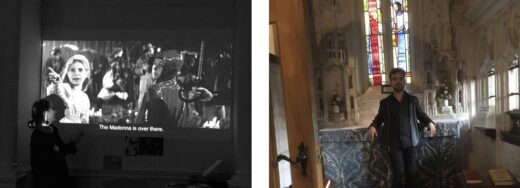
Left: Nina Danino alongside La Dolce Vita (1960)
Right: David Leal inside the Collegiate Church of St Mary, Warwick
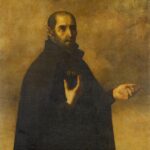
St. Ignatius Loyola (c 1634-50), Francisco Zurbarán (1598-1662)

